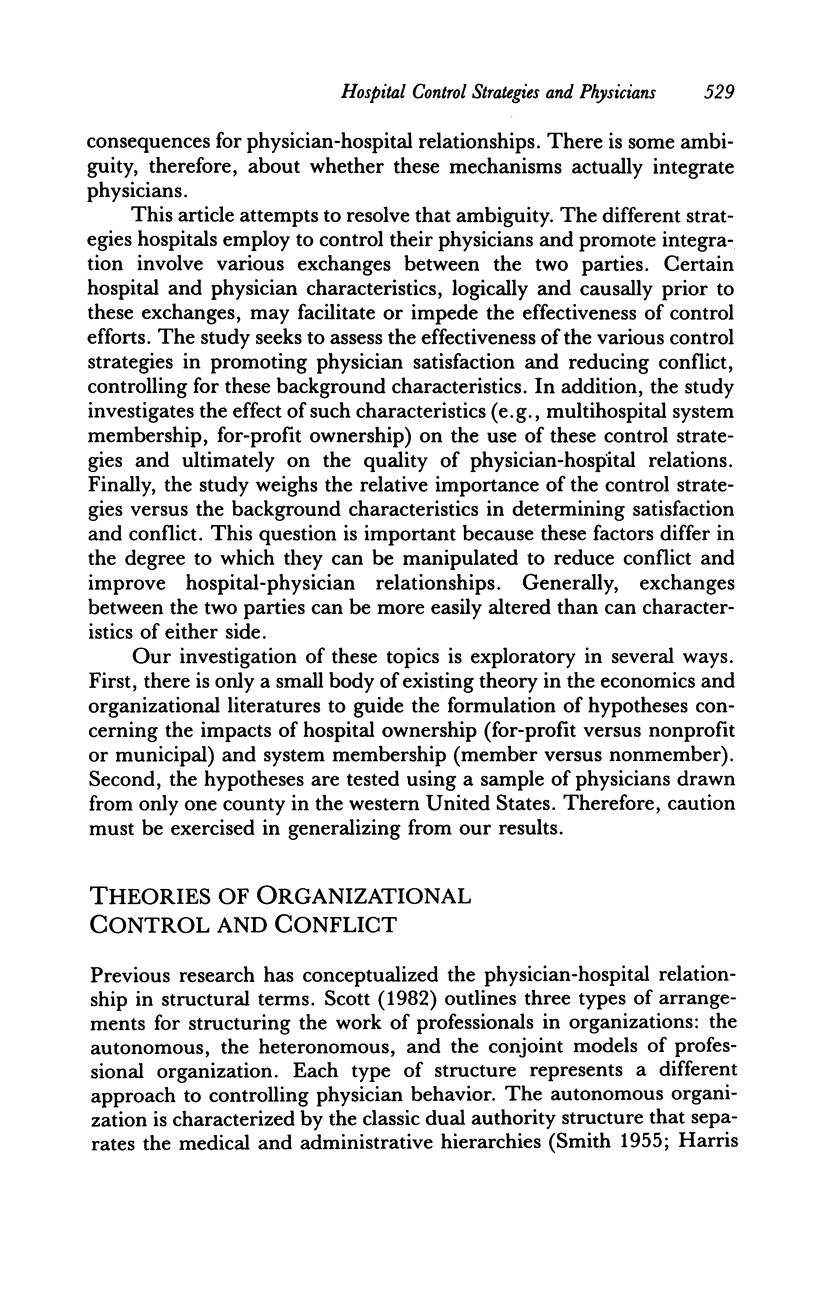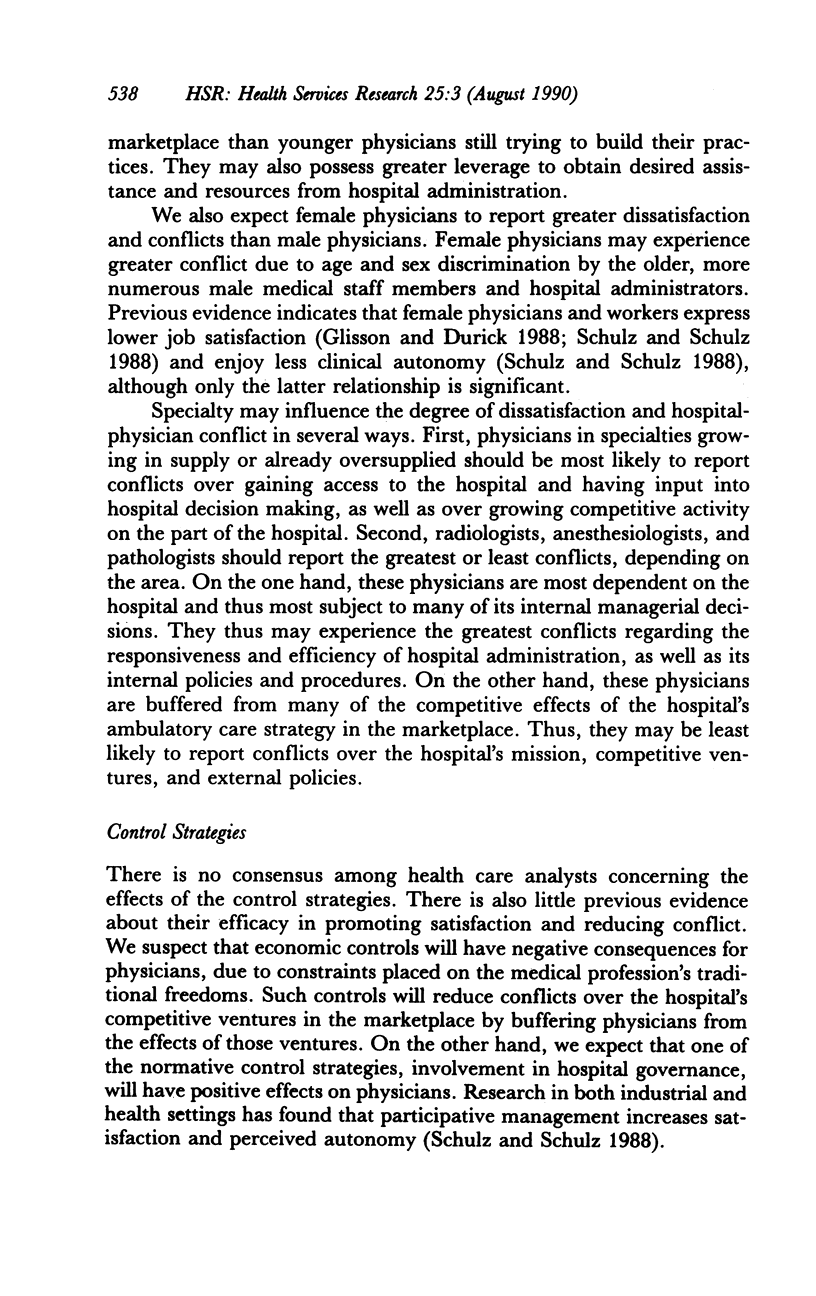Abstract
This article examines several strategies that hospitals use to control their medical staffs. Such strategies include placing physicians on salary, developing exclusive hospital affiliations with physicians, and involving physicians in decision-making bodies. Using regression techniques, we investigate which hospitals are more likely to utilize these strategies and whether such strategies are effective in promoting physician-hospital integration. Contrary to our expectations, corporate hospital structures (e.g., for-profit hospitals, membership in multihospital systems) generally do not employ these strategies more often and oftentimes employ them less. There is also little evidence that control strategies are effective levers for increasing physician satisfaction or decreasing physician-hospital conflict. We suggest that control strategies are useful for purposes other than promoting physician-hospital integration. Finally, hospital ownership appears to exert the biggest effect on physician satisfaction and conflict.
Full text
PDF

































Selected References
These references are in PubMed. This may not be the complete list of references from this article.
- Alexander J. A., Morrisey M. A., Shortell S. M. Effects of competition, regulation, and corporatization on hospital-physician relationships. J Health Soc Behav. 1986 Sep;27(3):220–235. [PubMed] [Google Scholar]
- Breslau N., Novack A. H., Wolf G. Work settings and job satisfaction: a study of primary care physicians and paramedical personnel. Med Care. 1978 Oct;16(10):850–862. doi: 10.1097/00005650-197810000-00005. [DOI] [PubMed] [Google Scholar]
- Engel G. V. The effect of bureaucracy on the professional autonomy of the physician. J Health Soc Behav. 1969 Mar;10(1):30–41. [PubMed] [Google Scholar]
- Glandon G. L., Morrisey M. A. Redefining the hospital-physician relationship under prospective payment. Inquiry. 1986 Summer;23(2):166–175. [PubMed] [Google Scholar]
- Herzlinger R. E., Krasker W. S. Who profits from nonprofits? Harv Bus Rev. 1987 Jan-Feb;65(1):93–106. [PubMed] [Google Scholar]
- Lichtenstein R. L. The job satisfaction and retention of physicians in organized settings: a literature review. Med Care Rev. 1984 Fall;41(3):139–179. doi: 10.1177/107755878404100301. [DOI] [PubMed] [Google Scholar]
- Linn L. S., Brook R. H., Clark V. A., Davies A. R., Fink A., Kosecoff J. Physician and patient satisfaction as factors related to the organization of internal medicine group practices. Med Care. 1985 Oct;23(10):1171–1178. doi: 10.1097/00005650-198510000-00006. [DOI] [PubMed] [Google Scholar]
- Madison D. L., Konrad T. R. Large medical group-practice organizations and employed physicians: a relationship in transition. Milbank Q. 1988;66(2):240–282. [PubMed] [Google Scholar]
- Mick S. S. Sector theory, stratification, and health policy: foreign and U.S. medical graduates in medical practice. J Health Soc Behav. 1987 Mar;28(1):74–88. [PubMed] [Google Scholar]
- Okorafor H. Hospital characteristics attractive to physicians and the consumers: implications for public general hospitals. Hosp Health Serv Adm. 1983 Mar-Apr;28(2):50–65. [PubMed] [Google Scholar]
- PORTER L. W., LAWLER E. E., 3rd PROPERTIES OF ORGANIZATION STRUCTURE IN RELATION TO JOB ATTITUDES AND JOB BEHAVIOR. Psychol Bull. 1965 Jul;64:23–51. doi: 10.1037/h0022166. [DOI] [PubMed] [Google Scholar]
- Riffer J. Physicians trade private practice for security. Hospitals. 1986 Aug 20;60(16):66–66. [PubMed] [Google Scholar]
- SMITH H. L. Two lines of authority are one too many. Mod Hosp. 1955 Mar;84(3):59–64. [PubMed] [Google Scholar]
- Schlesinger M., Marmor T. R., Smithey R. Nonprofit and for-profit medical care: shifting roles and implications for health policy. J Health Polit Policy Law. 1987 Fall;12(3):427–457. doi: 10.1215/03616878-12-3-427. [DOI] [PubMed] [Google Scholar]
- Scott W. R. Managing professional work: three models of control for health organizations. Health Serv Res. 1982 Fall;17(3):213–240. [PMC free article] [PubMed] [Google Scholar]
- Shortell S. M., Morrisey M. A., Conrad D. A. Economic regulation and hospital behavior: the effects on medical staff organization and hospital-physician relationships. Health Serv Res. 1985 Dec;20(5):597–628. [PMC free article] [PubMed] [Google Scholar]
- Shortell S. M. The medical staff of the future: replanting the garden. Front Health Serv Manage. 1985 Feb;1(3):3–48. [PubMed] [Google Scholar]
- Steers R. M. Antecedents and outcomes of organizational commitment. Adm Sci Q. 1977 Mar;22(1):46–56. [PubMed] [Google Scholar]
- Wallace C. Physicians leaving their practices for hospital jobs. Mod Healthc. 1987 May 8;17(10):40-8, 55-7. [PubMed] [Google Scholar]


